Common Connection Errors / Solutions Error 650: Server not Responding Runtime error 650 is a common connection error that occurs when your computer cannot establish a connection. Let our new Connection Wizard pinpoint your problem! The Juno Connection Wizard is our newest help tool. Download it today to identify and resolve many common issues that may prevent you from successfully connecting to the Internet. To use the Juno Connection Wizard, you will need to have a Windows Operating System (other than Windows NT) running on your computer. If you cannot download the Juno Connection Wizard from your computer, simply download it onto a diskette from any computer with Internet access and then install it on the computer you would like to fix. Click here to download the Connection Wizard. |
Follow the steps below to resolve the issue. A. Is your access number valid? Note: If you are subscribed to Juno's Toll-Free service please skip to step B.To find available access numbers in your area, click here. Please check with your telephone company to confirm that under your calling plan the chosen access numbers will not result in additional charges. You are solely responsible for all telephone charges related to accessing our services and Juno will not reimburse you for any such charges, including long distance or toll charges.
B. Configure the Windows Network Components for Dial-Up-Networking The following instructions are for those systems that are not on a Local Area Network (LAN). If you are on a LAN and follow these directions, you may create a conflict that will disrupt your computer's connection to your network. Please contact your network administrator for assistance before you continue making any changes to the system configuration. - Click on the Windows Start button, point to Settings and select Control Panel.
 - Double-click the Network icon.
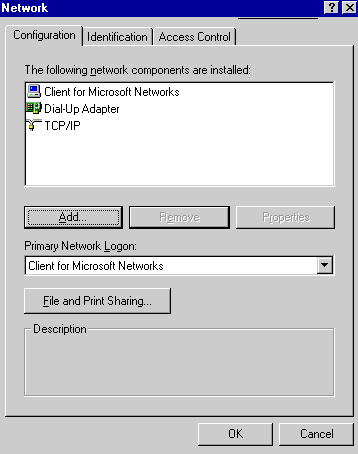 - What you will find listed under the Configuration tab will depend on your version of Windows. Juno requires three network components total, but you may have more or less listed. The three that are required are:
- Client for Microsoft Networks
- Dial-Up Adapter
- TCP/IP
Note: You may see TCP/IP->Dial-up Adapter grouped together.
To Add Client for Microsoft Networks: 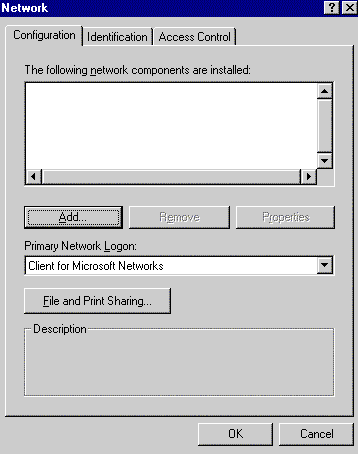 - Click on the Add button.
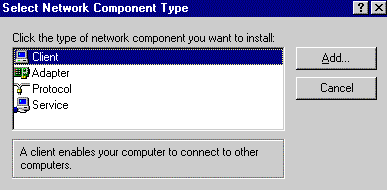 - Select Client.
- Click on the Add button.
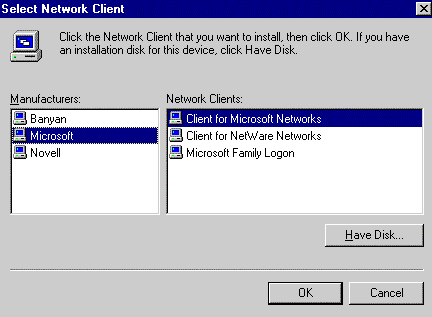 - Under Manufacturers, select Microsoft.
- Under Network Clients, select Client for Microsoft Networks.
- Click OK.
To Add Dial-up Adapter: - Click on the Add button.
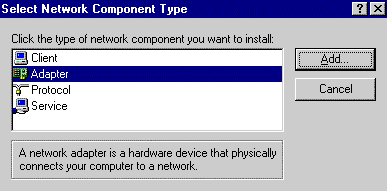 - Select Adapter.
- Click on the Add button.
 - Under Manufacturers, select Microsoft.
- Under Network Adapters, select Dial-Up Adapter.
- Click OK.
To Add TCP/IP: - Click on the Add button.
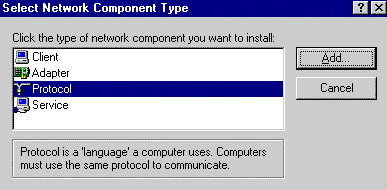 - Select Protocol.
- Click on the Add button.
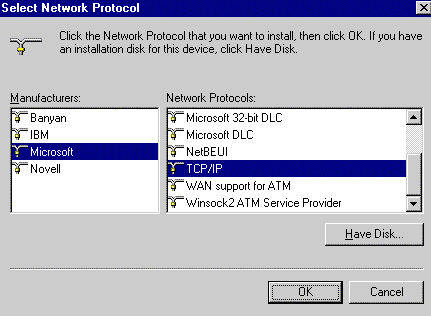 - Under Manufacturers, select Microsoft.
- Under Network Protocols, select TCP/IP.
- Click OK.
Once you have confirmed that the three required Network components are installed, ensure that TCP/IP is correctly configured.
C. Check Network Settings  - On your desktop, double-click the My Computer icon.
 - Double-click the Control Panel icon.
 - Double-click the Network icon.
IMPORTANT! Before making any changes to your Network settings, please ensure that you have your Windows CD.
 Note: In the Primary Network Logon drop-down menu, ensure that Client for Microsoft Networks is selected.
- Double-click TCP/IP->Dial-Up Adapter.
Note: If you get a TCP/IP Properties Information window, click OK.  - Ensure that only the circle next to Obtain an IP address automatically is checked.
- Select the WINS Configuration tab.
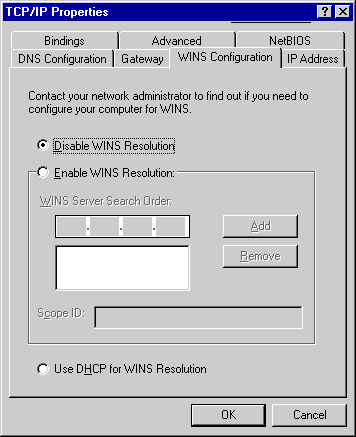 - Ensure that only the circle next to Disable WINS Resolution is checked.
- Select the Gateway tab.
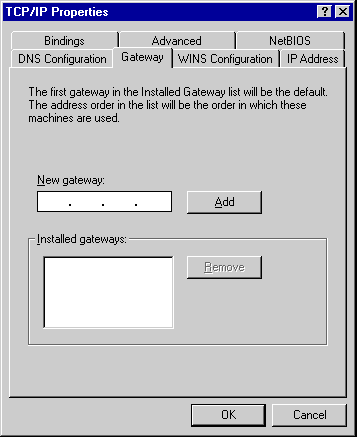 - Ensure that all the fields are blank.
- Select the DNS Configuration tab.
 - Ensure that the circle next to Disable DNS is checked.
- Select the Bindings tab.
 - Ensure that only Client for Microsoft Networks is checked.
- Select the Advanced tab.
 - Ensure that None is in the Property field.
- Select the NetBIOS tab.
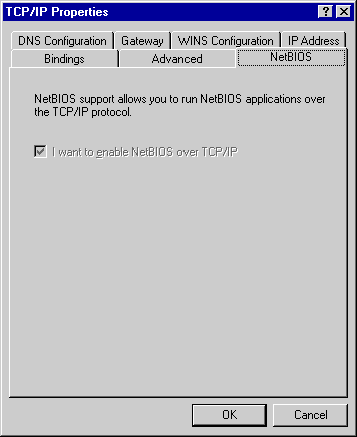 - No changes are necessary.
- Click OK.
- Click OK to exit.
D. Next, you will need to set up this computer's identity. - Select the Identification tab at the top of the Network properties window. We will want to change the entry here for Computer Name.
Here is an example:- Computer Name: Juno
- Workgroup: Workgroup
- Computer Description: Mine
 - Click OK.
You may now be prompted for the Windows CD-rom, or the file copy may begin automatically. If prompted for the Windows CD, insert the CD and click OK. If you are still prompted for it after clicking OK, verify that the drive letter listed in Copy files from is your CD-rom drive.
Note: If, during this process, you see a warning about "Version Conflict" or "A file being copied is older," click No. If you are prompted that the "file is not found," you are not using the CD-rom that was used to install Windows on your machine. Note: If you made any changes or added any components, the following window will appear.

Click Yes to restart your computer. When Windows restarts, you may see a dialog box asking for a Username and Password to log in.  For Username, enter the same name that you entered for Computer Name in the prior step in the same lower case format. Do not enter a Password. Click OK. If asked to confirm, click OK.
E. Identifying and Disabling 56k Modems
This procedure will disable any 56k protocols that your modem supports. While this will slow down the modem's initial connection rate, it will stabilize the connection.
Note: Juno does not support 56K X2. From region to region, the quality of the phone lines will vary. In some areas, your phone lines may not support high speed modem connections due to phone lines of marginal quality. Please contact your local phone company for details in your area. In order to get a stable connection, you will need to identify your modem and place an extra setting (or INIT STRING) in Modem properties. To identify your modem - Disconnect any active connections and reboot the computer if necessary.
- Click on the Windows Start button.
- Point to Settings and select Control Panel.
 - Double-click on Modems.
- Select the Diagnostics tab.
 - Select the Com Port that the modem is on and click on the More Info button.
You can find the name of the manufacturer listed under the Command and Response table of the More Information screen. You may see US Robotics, 3Com or LT WinModem. If you own a Rockwell modem, the listing for ATI3 would be either a number in the form 2.x.xxx.x or 2.xxx_k56flex. A 56k Cirrus Logic modem would be indicated by CL-MD-56xx or something similar. To add the Extra Setting: - Click on the Windows Start button.
- Point to Settings and select Control Panel.
 - Double-click the Modems icon.
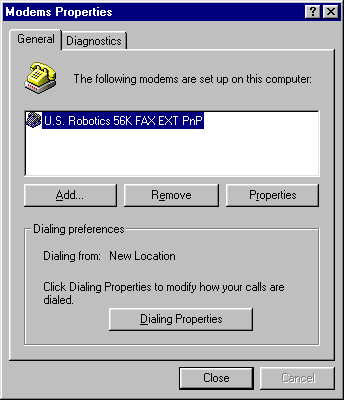 - Highlight your modem and select Properties (NOT dialing properties).
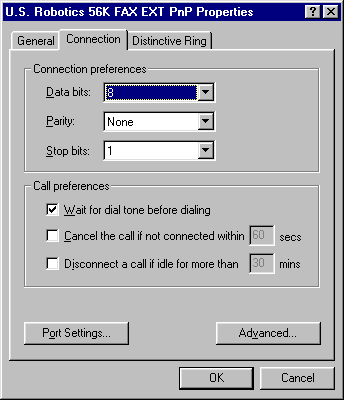 - Select the Connection tab.
- Click on the Advanced button.
 - At the bottom, there is a field called Extra Settings.
For US Robotics modems you have three options, type:
1) For USRobotics, Sportster 28.8 V.34 modems use "AT&F1&D0S0=0"
2) For USRobotics, Sportster 28.8 & 33.6 modems use "AT&F1S15=12"
3) For USRobotics, Sportster 56K X2 (off) use "s32=32"
Note: Juno does not support X2 dial up connections, so by using the above INIT string it will turn the X2 technology off, and allow you to connect.
For LT Winmodems you have three options, type:
1) For Lucent Technologies, LT WinModem use "AT&FX "
2) For Lucent Technologies, LT Winmodem 56Kflex (Disabled) use "S38=0"
3) For Lucent Technologies, LT Winmodem (Disabled) other types"
For PCTel modems you have three options, type
1) PC-Tel, 28.8 & 33.6 modems use
"AT&D2&C1X4V1Q0S7=70W2\N3&K3"
2) PC-Tel, HSP Deluxe 33.6 modems use "AT&F&C1&D2&K3W1"
3) PC-Tel, 'MicroModem' modems use "AT&F&C1&D2&K3W1"
For Rockwell modems you have three options, type:
1) Rockwell Based 56k HCF V. 90 modems use "AT&FE0V1S0=0&C1&D2W0"
2) Rockwell Based 56k HCF 56kflex modems use "+MS=k56flex"
3) Rockwell Based 56k modems use "AT&F&W&W1E0X4W2"
For Cirrus Logic modems you have three options, type:
1) Cirrus Logic, 14.4 modems use "AT&F&C1&D2\Q3%C0"
2) Cirrus Logic, 33.6 modems use "AT&F\N0%C0"
3) Cirrus Logic, 56k X2 modems use "S32=32&N16&U10" - Click OK, then click OK again.
- Click on the Windows Start button and select Shutdown.
- Restart your computer.
- Retry your Juno connection.
| |